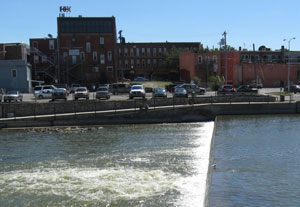Editor’s note: Areas of Concern are one of the issues that will be discussed Oct. 11-14 in Detroit at the 2011 Great Lakes Week. Detroit Public Television is providing ongoing coverage of Great Lakes Week at greatlakesnow.org.
 The mouth of a Michigan river with a history of environmental problems will again flow naturally and reconnect Lake Erie to inland towns.
The mouth of a Michigan river with a history of environmental problems will again flow naturally and reconnect Lake Erie to inland towns.
But the project could introduce new problems.
Officials in Monroe, Mich., 40 miles south of Detroit, are cleaning up the River Raisin and altering a series of dams to allow natural flow. The project will let fish swim up the river and canoeists and kayakers to enjoy the 23 miles of the river before it empties in Lake Erie.
The city is now opening water flow in the lower three miles of the river, which has four dams. The second phase opens the next 20 miles upstream, which has four dams. Some dams cannot be removed because they are built above sewer pipes that are at a certain elevation for gravity flow. So planners are researching other ways to create natural flow.

A series of dams on the River Raisin were constructed to for sewers running beneath them but for years the dams have blocked boats and fish from travelling back up the Raisin from Lake Erie. Photo: monroemi.gov
“Two of the four dams in the first phase have sewer lines that are still used,” said Michelle LaRose, water resource engineer with Cardno JFNew, an environmental consulting company working with the city. “We are looking at constructing a rock arches that will create rapids and spawning habitat.”
These arches are ramps built up the face of the dam with rocks. They let paddlers go down the ramp and fish swim upstream.
The dams without active sewer lines will be notched with openings large enough for the river to resume its natural course.
“We want the habitat restoration,” said Daniel Stefanski, the Monroe County drain commissioner. “But we could also get a little whitewater and let the kayakers go crazy.”
A concern is whether improvements for fish and paddlers have unintended consequences.
Rock arches could drive upstream water levels up and increase flooding.
Cardno JFNew has run models that haven’t shown an increase with installed rock arches. But the models aren’t perfect.
“There’s not a really good way to model water levels before we actually start the project,” LaRose said.
If modeling shows rising water levels, residents would have to approve of the project, she said. ”This is a challenge we want to avoid.”
In addition to flooding, unwanted invasive plants could benefit from the new water flow.
The city lowered water levels in recent years to help starve off nearby invasive plants. The rock arches could once again fuel their growth.
“We’ve sprayed and pulled invasive plants along the river, which has retarded their growth a bit,” Stefanski said. “But what’s really helped is lowering the water levels.”
Additionally, as with any project in a river, there is potential to disrupt habitat and sensitive species, LaRose said.
“There could be existing mussel species where we want to do work, which would pose a problem,” she said. “We’re doing surveys of endangered mussels in the area right now … we could relocate them to another part of the river if we had to.”
But mussels depend on fish moving up and down the river, so this should benefit the species, said Michelle Selzer, an environmental quality analyst with the Michigan Department of Environmental Quality.
And despite the other potential problems, “the River Raisin is a good news story,” Selzer said.
“The River Raisin has potential to be the first Michigan Area of Concern to be delisted,” Selzer said.
Areas of Concern are U.S. and Canadian designated areas with serious environmental problems in the Great Lakes. River Raisin’s lower 2.6 miles are listed as an Area of Concern.
While there are challenges, the project will directly benefit fish and wildlife habitat — one of the conditions Area’s of Concern must address, according to Selzer.
The project is part of a larger environmental plan for the River Raisin. Oil, grease, heavy metals and polychlorinated biphenyls (PCBs) went into the river from nearby industry for years. Additionally, nearby waste disposal sites are suspected of contamination, according to the EPA.
This contamination is blamed for loss of fish and wildlife habitat, increased algae and beach closings. The river will be dredged to remove pollutants before the dam work, Stefanski said.
“The goal is to get de-listed,” Stefanski said. “If we remove a good amount of contaminated sediment, and improve this habitat and fish passage, it goes a long way toward our goal.”
The project was scheduled to start this past August but has been delayed until August 2012, LaRose said.